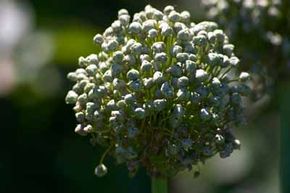Although they're onions, these ornamental plants have no unpleasant scent unless cut. Some are actually sweetly perfumed. Alliums are useful in the garden because they bridge the gap between spring-flowering and summer-flowering bulbs. Most bloom for several weeks in June and July.
Description of flowering onion: Alliums bear spheres or loose clusters of star-shaped flowers in shades of pink, white, blue, purple, or yellow. There are both tall-growing species (to 4 feet or higher) and miniature ones. Their attractive leaves, often a lovely blue-green, appear in early spring but fade away in early summer, often just as the plant is flowering. Ease of care: Easy.
Advertisement
Growing flowering onion: Plant small bulbs 3 to 4 inches deep, large ones 6 to 8 inches deep, in a sunny, well-drained area. Winter mulching is advisable in colder climates.
Propagating flowering onion: By division or seed.
Uses for flowering onion: Low-growing alliums are ideal plants for borders and rock gardens. Tall-growing alliums make wonderful cut flowers; soak their stems in cold water for 10 minutes to remove any scent of onion. They are also attractive in beds and borders of all sorts.
Flowering onion related species: Allium giganteum produces huge 6-inch globes of purple flowers on top of 3- to 6-foot stems and may require staking. Drumstick allium (A. sphaerocephalum) bears 2-foot stems with smaller clusters of reddish purple flowers. Blue garlic (A. caeruleum) is similar but with blue flowers. Yellow allium (A. moly) produces yellow flowers in loose clusters on 10-inch stems. A. neapolitanum is similar but with beautifully perfumed white flowers; it is hardy only to USDA zone 6.
Scientific name of flowering onion: Allium species
Advertisement
